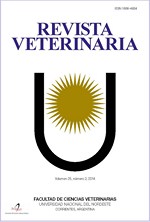Linking epidemiology, biostatistics and animal welfare science
DOI:
https://doi.org/10.30972/vet.3326186Keywords:
Biostatistics, Collaborative work, Epidemiology, Multidisciplinary, TeamworkAbstract
Different epidemiological techniques and bio-statistical approaches are put into an animal welfare scientific context, in a variety of species and settings, with reference to a variety of studies provided as examples for reference. Epidemiology is especially important in animal welfare science allowing the use of complex settings outside the laboratory environment using models that account for random factors. It is also important in the introduction of standardised techniques allowing evidence synthesis.Downloads
References
Lau B et al. 2020. Perspectives on the future of epidemiology: a framework for training. Am J Epidemiol 189: 634–639.
Mata F. 2013. Mastitis vaccination in dairy cattle: a meta-analysis of case-control trials. Revista Portuguesa de Ciências Veterinárias 108: 17-22.
Mata F. 2014. Analysis of predisposition factors for limb amputation in dogs with survival analysis in those diagnosed with appendicular cancer. Veterinary Nurse 5: 406-411.
Mata F. 2014. Evaluation of horse fitness for exercise: the use of a logit-log function to model horse post-exercise heart rate recovery. J Equine Vet Sci 34: 1055-1058.
Mata F. 2015. The interactive effects of diet, age and teeth in the oral health of cats. Anim 5: 101-107.
Mata F. 2021. A framework for using epidemiology in animal welfare science. J Appl Anim Welf Sci (epub ahead of print).
Mata F, Johnson C, Bishop C. 2015. A crosssectional epidemiological study of incidence of bit injuries in polo and race horses. J Appl Anim Welf Sci 18: 259-268.
Mata F, Lam A. 2013. Investigating the relationship between feed and helminthic burden of captive birds of prey in Hong Kong. Zoo Biol 32: 652-654.
Mata F, Mwakifuna B. 2012. Comparative mortality and predation in relation to egg production traits of Rhode Island Red, Black Australorp and Hyblack laying hens in scavenging production systems of rural Malawi. Brit Poultry Sci 53: 570-575.
Mata F, Williams J, Marks F. 2012. Investigation of factors associated with the probability of racehorses being pulled up in steeplechase races
at Cheltenham racetrack. Comp Exercise Physiol 8: 95-101.
Scarazzati S, Wang L. 2019. The effect of collaborations on scientific research output: the case of nano-science in Chinese regions. Scientometrics 121: 839-868.
Willeberg P. 1997. Epidemiology and animal welfare. Proceedings of the 8th International Symposium on Veterinary Epidemiology and Economics. Épidémiologie et Santé Animale, Paris, France.
Williams J, Parrot R, Damata F. 2012. The effect of manual and motorised dental rasping instruments on thoroughbred heart rate and behaviour. J Vet Behav 7: 149-156.
Downloads
Published
How to Cite
Issue
Section
License
Revista Veterinaria (Rev. Vet.) maintains a commitment to the policies of Open Access to scientific information, as it considers that both scientific publications as well as research investigations funded by public resources should circulate freely without restrictions. Revista Veterinaria (Rev. Vet.) ratifies the Open Access model in which scientific publications are made freely available at no cost online.











.jpg)
.jpg)



